Tips for using Recycle Bin more effectively
Every Windows built-in tool contains useful features for users, Recycle Bin is no exception. If you don't know how to actually delete the file when you press Delete instead of transferring it to the Recycle Bin, limit the Recycle Bin, restore the deleted file from the Recycle Bin or hide the Recycle Bin icon from the desktop, then you are in the right place. already.
Please refer to the tips below to customize the Recycle Bin to suit your purpose of using your computer.
Tricks with Recycle Bin
- 1. Delete the file permanently
- 2. Limit file size in Recycle Bin
- 3. Recover files in Recycle Bin
- 4. Hide the Recycle Bin icon on the Desktop
- 5. Display the Recycle Bin in the system tray
- 6. Turn off the file deletion confirmation message
- 7. Change the icon of Recycle Bin
- 8. Rename Recycle Bin
- 9. Change the sound of Recycle Bin
- 10. Analyze your computer's Recycle Bin
1. Delete the file permanently
When you delete a file, it will still be saved to the Recycle Bin without being deleted from memory. At this point, it will switch to standby status in Recycle Bin and still occupy part of the storage space on your hard drive. If you want to permanently delete a file, just hold down the Shift key and press Delete to finish.
To set the mode to skip Recycle Bin, right-click the trash icon, select Properties. In the customized dialog box, check the section Don't move file to the Recycle Bin . and click OK
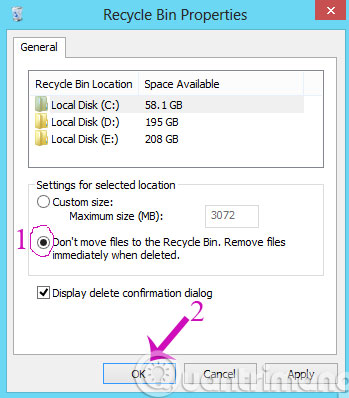
2. Limit file size in Recycle Bin
If you still don't want to delete the files you want to keep them in the Recycle Bin before deciding to delete them completely, you must set the size limit of these files to limit the usage of the set. mind. If the total size of the files in the Recycle Bin exceeds the limit, it will automatically delete the oldest files.
You also right-click the trash icon, select Properties . In the custom dialog box, enter the maximum size in Maximum size. Then click OK .
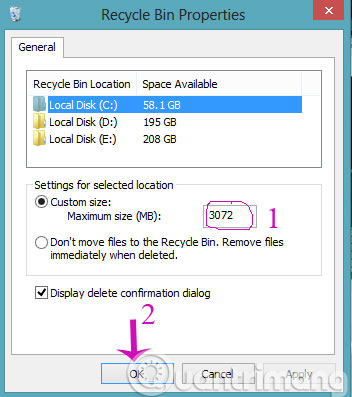
3. Recover files in Recycle Bin
If you want to restore the files in the Recycle Bin to their original location, double-click the Recycle Bin and select the file you want to restore and click Restore the selected items on the toolbar. Now these files will disappear from the Recycle Bin and return to where you deleted them.
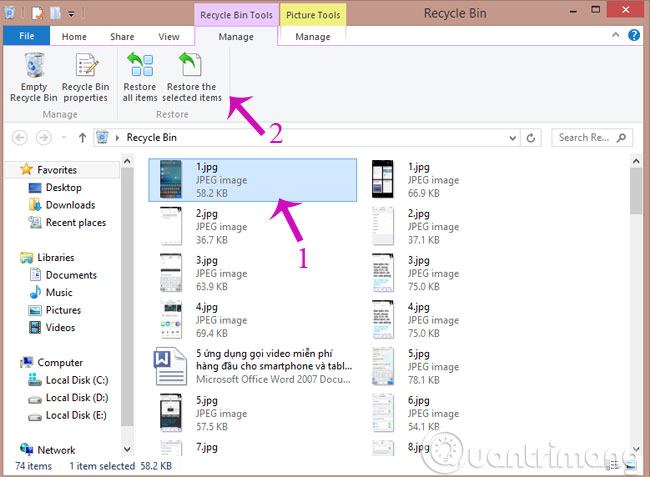
4. Hide the Recycle Bin icon on the Desktop
You may have noticed that when you installed Windows operating system, the Recycle Bin icon will also appear on the screen. But if you want to hide this icon again, do the following.
Go to Control Panel / Change the theme (Appearance and Personalization) / Change desktop items . The options dialog box will appear, uncheck the Recycle Bin box and click OK.
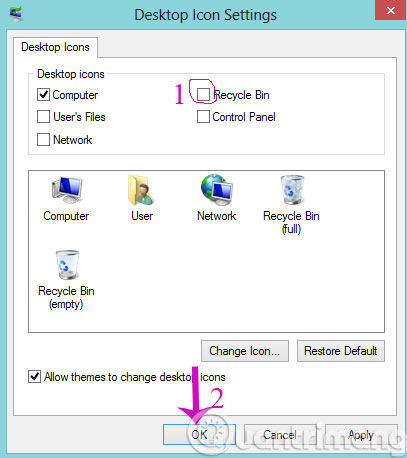
5. Display the Recycle Bin in the system tray
If you want to easily use Recycle Bin, you can set it to display in the system tray along with other Windows system notification icons. To do this, try using MiniBin. MiniBin provides options in the right-click menu such as emptying the recycle bin to delete all files or open the recycle bin to display deleted files. This tool uses very little memory and integrates seamlessly with the default system icon, just like Microsoft created.
Download : MiniBin

Let this program start automatically with Windows, drag and drop its .exe file into the Startup folder in the Start menu.
6. Turn off the file deletion confirmation message
If you don't like the message ' Are you sure you want to move this file to the Recycle Bin? 'appears when deleting the file, you can disable this confirmation message by right-clicking on the Recycle Bin icon on the desktop and selecting Properties , unchecking the option Display delete confirmation dialog .
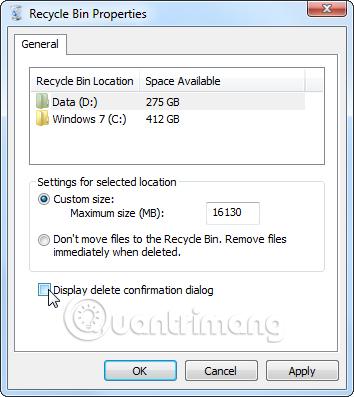
7. Change the icon of Recycle Bin
From the Desktop Icon Settings window, you can change the Recycle Bin icons to personalize the Recycle Bin. Select the Recycle Bin icon, click the Change Icon button and browse to the image file you want to use. You can set up a separate icon when the Recycle Bin is empty or full.
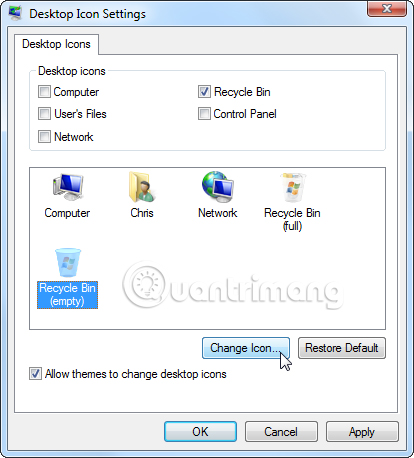
To undo your changes in the future, select the icon and use the Restore Default button. Note, your Recycle Bin icon will change if you select another theme in Windows, so to prevent this from happening, uncheck the option Allow themes to change desktop icons .
8. Rename Recycle Bin
In addition to changing the Recycle Bin icon, you can change its name by right-clicking on the Recycle Bin in the desktop and selecting Rename . You can change the name to anything you want.
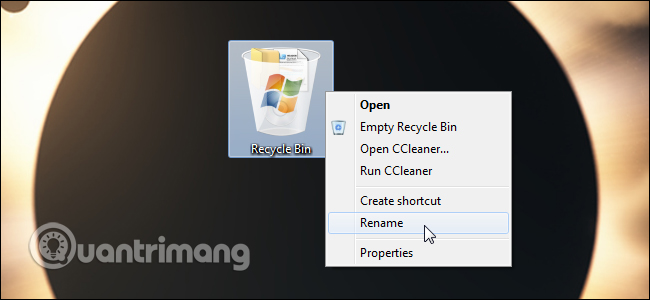
9. Change the sound of Recycle Bin
If you don't like the sound emitted when cleaning up the Recycle Bin, you can set another sound or mute it completely. To do so, click the Sounds icon at the bottom of the Personalization window (right-click and the desktop and select Personalize to open it).
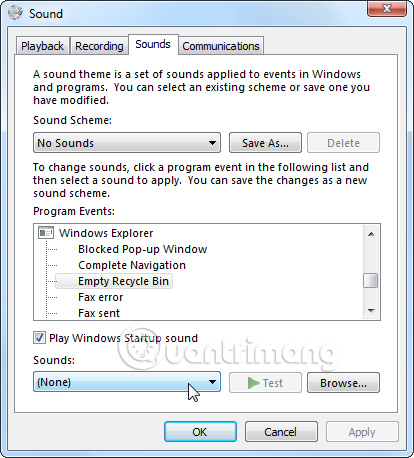
Select the Empty Recycle Bin sound in Windows Explorer and select the sound you like. You can choose one of the Windows audio or browse to your audio file.
10. Analyze your computer's Recycle Bin
Rifiuti2 is a computer "forensic" tool to analyze the contents of your computer's Recycle Bin. Run it and it will collect information about deleted files in the Recycle Bin such as their name, deletion time, initial path and their size. Note that you will need to install Cygwin to use this command line tool. Many users may not need this tool, but if you are interested in doing some analysis on your computer's Recycle Bin, this is a useful tool.
Hopefully, the tips we have just introduced above will help you to manipulate and manage files in your computer better.
See more:
- Delete data from your computer: Make sure all the files you put in the Trash actually disappear
- 5 ways to overcome the situation of slow computer
- Delete Files on Mac - Empty Trash or Secure Empty Trash?
Good luck!
You should read it
- 5 Recycle Bin settings on Windows 11 you should know
- Automatically 'clean up' the Recycle Bin on Windows 10
- How to fix Recycle Bin not self-cleaning on Windows 10
- Simple tips to clean Recycle Bin on Windows 10
- How to Restore the Recycle Bin
- How to set up automatic emptying of the recycle bin in Windows 11
- Simple way to integrate CCleaner into the right-click Recycle Bin menu
- How to create a shortcut to clean the Recycle Bin on Windows 10/11
May be interested
- Simple way to integrate CCleaner into the right-click Recycle Bin menu
 ccleaner is one of the most popular system cleaning and optimization software available today. and it will be even more convenient if you combine this operation to clean up the recycle bin by integrating this useful tool into the recycle bin right-click menu. if you do not know how to do it, you can follow our steps below.
ccleaner is one of the most popular system cleaning and optimization software available today. and it will be even more convenient if you combine this operation to clean up the recycle bin by integrating this useful tool into the recycle bin right-click menu. if you do not know how to do it, you can follow our steps below. - How to create a shortcut to clean the Recycle Bin on Windows 10/11
 the windows recycle bin icon on the desktop is a shortcut to open that archive of deleted files. however, some users may prefer to have a shortcut to emptying that recycle bin instead of accessing it.
the windows recycle bin icon on the desktop is a shortcut to open that archive of deleted files. however, some users may prefer to have a shortcut to emptying that recycle bin instead of accessing it. - How to change the Windows 11 Recycle Bin icon
 switching the recycle bin icon in windows 11 simplifies wallpaper customization, giving you the look and feel that suits your taste or theme.
switching the recycle bin icon in windows 11 simplifies wallpaper customization, giving you the look and feel that suits your taste or theme. - How to Pin the Recycle Bin in Windows 10
 there are a lot of reasons why someone would want to pin the recycle bin. most of the time, it is just for the convenience of having often-used system folders right where you like them. in windows 10, you have a couple of different options...
there are a lot of reasons why someone would want to pin the recycle bin. most of the time, it is just for the convenience of having often-used system folders right where you like them. in windows 10, you have a couple of different options... - How to add Recycle Bin to Windows 11 system tray
 although the default desktop shortcut is a useful tool, windows 11 does not allow you to add the recycle bin icon to the system tray.
although the default desktop shortcut is a useful tool, windows 11 does not allow you to add the recycle bin icon to the system tray. - How to Rename the Windows Recycle Bin
 have you ever wanted to give a clever name to the windows recycle bin? rename the recycle bin using the windows registry editor. start, run, 'regedit'.
have you ever wanted to give a clever name to the windows recycle bin? rename the recycle bin using the windows registry editor. start, run, 'regedit'. - How to Delete Files Directly Without Sending Them to Recycle Bin
 this wikihow article will teach you the simple and easy steps to directly delete files without sending them to the recycle bin. deleting files on the spot is a quick and convenient way to delete files without having to go into the recycle...
this wikihow article will teach you the simple and easy steps to directly delete files without sending them to the recycle bin. deleting files on the spot is a quick and convenient way to delete files without having to go into the recycle... - How to remove Properties from the Recycle Bin context menu in Windows 10
 if you do not want to allow others to access the properties menu, you can hide or delete it. in this tutorial, tipsmake.com will show you two methods to remove the properties option from the recycle bin context menu in windows 10.
if you do not want to allow others to access the properties menu, you can hide or delete it. in this tutorial, tipsmake.com will show you two methods to remove the properties option from the recycle bin context menu in windows 10. - Instructions to hide or delete Recycle Bin icon on Desktop Windows 7, 8, 10
 recycle bin is the place to store the data that you deleted from your computer. maybe for some reason you want to hide or delete the recycle bin icon from the desktop, you can refer to the steps in the following article of network administrator.
recycle bin is the place to store the data that you deleted from your computer. maybe for some reason you want to hide or delete the recycle bin icon from the desktop, you can refer to the steps in the following article of network administrator. - 4 ways to recover files from Recycle Bin in Windows 10
 windows temporarily stores deleted files and folders in the recycle bin so that they can be restored or permanently deleted.
windows temporarily stores deleted files and folders in the recycle bin so that they can be restored or permanently deleted.








 How to install Gadget for Windows 10 with Gadgetarian
How to install Gadget for Windows 10 with Gadgetarian Artistic Endeavors, master theme from Microsoft, invite download and experience
Artistic Endeavors, master theme from Microsoft, invite download and experience 5 alternatives to Windows Media Center in Windows 10
5 alternatives to Windows Media Center in Windows 10 How to manage and improve sound quality in Windows 10
How to manage and improve sound quality in Windows 10 Use Disk Defragmenter in Windows
Use Disk Defragmenter in Windows How to create and use useful Snipping Tool shortcuts in Windows
How to create and use useful Snipping Tool shortcuts in Windows